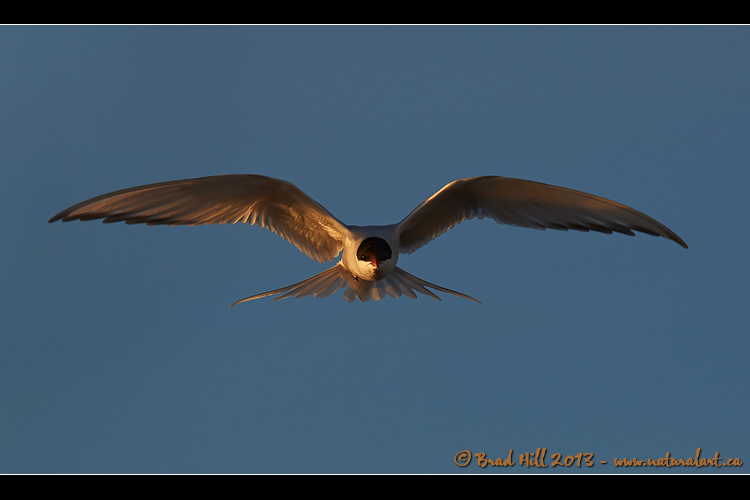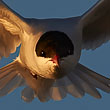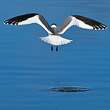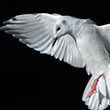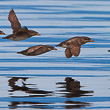Availability: Undetermined - Enquiries?
In the Field
Midnight Gold - Arctic Tern. Cambridge Bay, Victoria Island, Nunavut, Canada. July 1, 2013.
I captured this image of an adult Arctic Tern on my first trip into the land of the midnight sun - way up in the Canadian Arctic. I shot this image at 2 minutes to midnight when the sun was quite low in the sky, but still considerably above the horizon. The side-lighting illuminating the tern was incredibly warm and made the tern appear almost as a golden gem in the sky. If you're like most photographers and LOVE great light, nothing beats the long, long hours of rich, warm light you find in the far north near the time of the summer solstice. Mind you, the most dramatic light occurs between about 11 PM and 5 AM, so if you plan to take advantage of the light, be prepared to modify your circadian rhythm a tad!
Arctic Terns are absolute "champions" when it comes to traveling - they breed as far north as the northern tip of Greenland (at 84°N) and then many migrate all the way to wintering grounds on the edges of pack ice around Antarctica - an annual round-trip of about 40,000 km (which excludes their daily foraging flights). This "slackard" decided to spend its summer at only about 70°N!
The subject of this image was clearly focused on ME, and seconds after I shot this image it dove at me. It was pretty obvious that I had inadvertently strayed too close to its nest (tho' I never did see ithe nest), so I quickly left the area and when I was only a few meters away the bird immediately settled down.
I've made only very minor exposure adjustments to this image, and haven't enhanced the colour or "warmed" the image up at all - it's pretty much as seen. The strong side-lighting made for a very high-contrast scene, and I did have to expose for the highlights - in this case underexposing the image (compared to the "suggested" exposure as per my camera's matrix metering system) by just under one full stop - and then bring back some of the shadow detail during post-processing.
This is one of those images that pretty much needs to be seen in a large version to be appreciated - so here's a 2400 pixel version of it:
• Midnight Gold - Arctic Tern Download 2400 pixel image (JPEG: 829 KB)
NOTE: This image is protected by copyright - I'm fine with personal uses of it, but unauthorized commercial use of the image is prohibited by law. Thanks in advance for respecting my copyright!
Behind the Camera
Midnight Gold - Arctic Tern. Cambridge Bay, Victoria Island, Nunavut, Canada. July 1, 2013.
Digital Capture; Compressed RAW (NEF) 14-bit format; ISO 450.
Nikon D4 paired with Nikkor 400mm f2.8 VR - hand-held. VR on and in normal mode.
1/1600s @ f7.1; -0.67 stop compensation from matrix-metered exposure setting.
At the Computer
Midnight Gold - Arctic Tern. Cambridge Bay, Victoria Island, Nunavut, Canada. July 1, 2013.
RAW Conversion to 16-bit TIFF, including first-pass/capture sharpening using Capture One Pro version 7. Three raw variants (images processed from raw) differing by a total of 0.5 stops in total exposure.
Further digital corrections on resulting 16-bit TIFF files using Adobe's Photoshop CC and Light Craft's LightZone. Photoshop adjustments included compositing/blending the exposure variants, very minor colour tweaks (hue rotation and desaturation of selected colours), selective exposure tweaks and selective sharpening for web output. Final tone tweaking performed using tonemapper/re-light tool in Lightzone.
Conservation
Midnight Gold - Arctic Tern. Cambridge Bay, Victoria Island, Nunavut, Canada. July 1, 2013.
Species Status in Canada*: This species is not designated as at risk.
The Arctic Tern (Sterna paradisaea) is a medium-sized tern with a striking appearance - it has a distinct coal-black cap, blood red bill and legs, pale-gray upper wing with an outer web of black-tipped primary feathers, and a snow white throat, neck, and breast. Arctic Terns can have an extraordinarily long lifespan, living up to 34 years or more.
Arctic Terns are absolute "champions" when it comes to traveling - they breed as far north as the northern tip of Greenland (at 84°N) and then many migrate all the way to wintering grounds on the edges of pack ice around Antarctica - an annual round-trip of about 40,000 km (which excludes their daily foraging flights).
The present status of the Arctic Tern is only poorly known, largely owing to its remote nesting areas and wide dispersion of large fractions of the population. In southern New England, after recovery from nineteenth-century slaughter for the plume trade, peripheral populations have recently declined almost to extinction. In Greenland, large declines have been reported. Listed as Special Concern in Massachusetts and Maine, Threatened in New Hampshire. In Alaska, federally listed as species of conservation concern. In Canada, identified as "Sensitive" in Atlantic provinces, "Secure" in other areas: these designations provide no official protection.
*as determined by COSEWIC: The Committee on the Status of Endangered Wildlife in Canada













